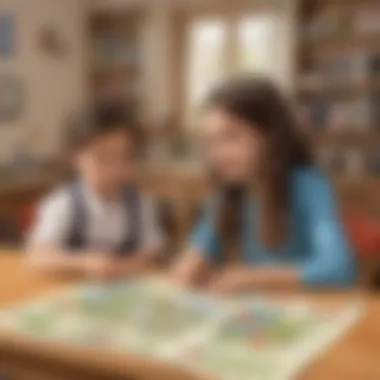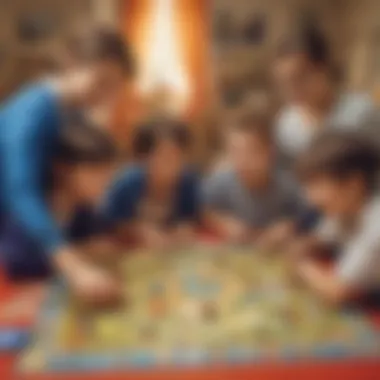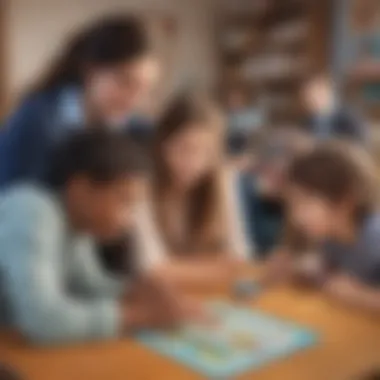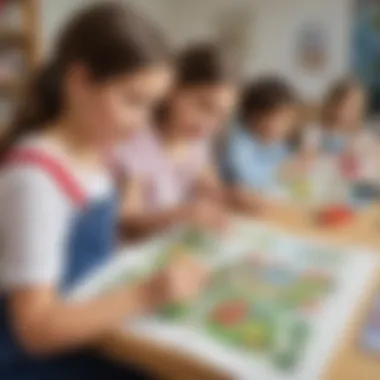Interactive French Games: Engaging Language Learning for Kids


Intro
In today's fast-paced world, where kids are bombarded with screens and distractions, finding effective ways to engage them in learning can be a challenge. One promising avenue is through immersive, interactive French games tailored for children aged 3 to 12. These games do more than just entertain; they become a conduit for language acquisition, enabling young learners to absorb new vocabulary and grammatical structures in a playful setting. Not only does this approach nurture language skills, but it also fosters cognitive and social development.
Interactive Learning Games
The world of interactive learning games is extensive and diverse. From simple word puzzles to dynamic role-playing games, each offers opportunities to learn while having fun. Let's explore some popular French games and their unique contributions to language learning.
Popular Games
- Duolingo: This app incorporates gamification concepts, where kids can learn vocabulary and pronunciation through short, themed exercise. The bright colors and engaging challenges captivate young minds.
- CocoMelon French Songs: This game fuses music and language, making learning engaging with animated songs that teach basic vocabulary in a catchy manner.
- LingoKids: A subscription-based platform, it offers a variety of games that adapt to children’s progress in learning French. Its gameplay is designed to make language learning feel like a natural extension of play.
Description of Top Educational Games
Consider the example of MindSnacks, which features fun mini-games tailored for acquiring a second language. With a focus on different learning styles, it accommodates not only visuals but also auditory feedback, ensuring that each child's learning preferences are catered to. Similarly, Quizlet can be adapted for French vocabulary and grammar, blending competitive elements with rewriting and multiple-choice questions.
Benefits of Playing Educational Games for Kids' Cognitive Development
Interactive games can bolster cognitive development in several ways:
- Enhancing memory: Repetition within game contexts helps reinforce memory retention.
- Encouraging problem-solving skills: Many games require critical thinking, pushing children to navigate challenges.
- Strengthening social skills: Multiplayer games encourage teamwork and communication among peers.
"Interactive learning is not just about fun; it’s a strategic approach towards holistic education that promotes language acquisition and cognitive growth."
Game Reviews
Engaging with educational games means understanding their effectiveness. Reviews provide insights into gameplay and outcomes, helping parents and educators gravitate towards the most valuable tools in language learning.
In-depth Reviews of Selected Educational Games
Games like LingoDeer have received praise for their comprehensive approach to teaching both language and culture, making them more than just vocabulary drills. Reviewers mention how the integration of cultural nuances keeps young learners interested and informed.
Comparison of Gameplay and Learning Outcomes
Comparing educational outcomes across various games can shed light on which methods work best. For example, Linguascope focuses on thematic vocabulary, encouraging immersive learning, while Kahoot! employs a quiz format that allows for competitive engagement among learners. Each game offers different learning experiences, which can be reviewed based on effectiveness in vocabulary retention and grammar acquisition.
Educational Topics
In addition to language skills, interactive French games can cover a broad spectrum of subjects, including math, science, and even arts. This interdisciplinary approach can be proven beneficial for children's holistic development.
- Mathematics: Games like Prodigy Math offer problem-solving that involves language elements.
- Science: Platforms like Science Buddies can initiate interest in science through French vocabulary relevant to various scientific concepts.
Tips and Tricks
For parents and educators looking to enhance the learning journey of children through these games, certain tips can optimize the effectiveness of play.
- Set a regular schedule: Consistency is key. Designating specific times for interactive gaming can encourage routine language practice.
- Engage with them: Play alongside the child, providing assistance or encouragement where necessary. This models positive learning behavior.
- Incorporate rewards: Positive reinforcement can go a long way. Accumulate points or rewards that children can exchange for small prizes.
Creative DIY Projects
Hands-on activities enrich a child’s learning experience and provide additional layers of engagement. Simple DIY projects can be integrated with language learning to enhance creativity and dexterity.
Step-by-Step Guides
Creating simple crafts, such as a French vocabulary flash card game, can be both educational and fun. Here's how you can do it:
- Gather materials: paper, markers, scissors.
- Write vocabulary words in French on one side and their translations on the other.
- Use these cards to play memory games or quiz your child about the French words.
Craft Ideas
Utilizing common household items for craft projects can also enhance learning. Ideas such as creating a collage of French landmarks or making a mini-book about French cuisine encourage exploration of language within cultural contexts. Art fosters creativity and improves fine motor skills, both critical in child development.
Interactive French games are not merely a hub for educational engagement but rather a gateway into a richer world of language and culture. By intertwining play and learning, these games pave the way for your child's linguistic journey.
Foreword to Interactive Language Learning
In today’s world, where the ability to communicate in multiple languages can significantly enhance life quality, learning a new language is more than just a classroom activity. Interactive learning, especially when it involves games, provides a dynamic approach to mastering a new language like French. This section lays the groundwork by looking into why embedding interaction in language learning is not just a trend, but a vital educational strategy.
Rationale Behind Interactive Learning


Interactive learning is about more than just memory drills and vocabulary tests. This approach engages children actively, making them participants in their own educational journey rather than passive recipients of information. The rationale behind this method lies in its capacity to cater to various learning styles, helping children absorb language concepts in a way that sticks. For instance, some kids thrive through auditory input, while others grasp concepts through visual aids or hands-on activities. Because games often engage multiple senses, they create an environment where children can learn naturally.
"Children learn best when they are having fun. The laughter and interaction from games make lessons memorable."
Moreover, when games are introduced, they often promote a sense of community among learners. Kids work side by side, excitedly helping one another, thus reinforcing both language skills and social bonds. This can be particularly important for young learners as they navigate complexity of understanding a new language.
The Role of Games in Education
Games in education play a multifaceted role that transcends simple enjoyment. They can foster motivation by making the learning process engaging and enjoyable. The competitive aspect of games can also spur students to improve and refine their skills continually. Games can act as a bridge between learning and play, with thoughtful design ensuring every activity has a purpose.
Moreover, through games, children get immediate feedback in a low-stakes environment. Whether they have succeeded or failed, the gaming platform allows them to try again without fear, thus cultivating resilience and a growth mindset. When a child sees that effort leads to improvement, it can change the way they approach learning in general.
Essentially, interactive French games wield a substantial influence on learning outcomes. They present opportunities for kids to practice language in realistic contexts, allowing them to feel more confident when using French in conversation outside the educational sphere.
This development leads to enthusiasm for cross-cultural exchange, helping children appreciate the rich linguistic landscapes beyond mere gameplay. By laying this educational groundwork, the article will explore specific French games, their benefits, and their practical applications in various learning environments.
Benefits of Learning French through Games
Learning a new language can sometimes feel like pulling teeth for kids. However, when you introduce an element of play, the landscape changes completely. Interactive games have a unique ability to transform what could be a tedious task into an enjoyable adventure. This section explores how learning French through games leads to various benefits that positively impact young learners. These benefits include cognitive development, social skills enhancement, and cultural awareness—each playing a crucial role in language acquisition.
Cognitive Development
Children's brains are like sponges, eager to soak up information. Engaging with interactive French games not only makes it fun but also stimulates cognitive growth. These games challenge your child’s problem-solving skills, enhance memory, and develop critical thinking abilities. For instance, games that require matching words with pictures force kids to recall vocabulary while making learning inherently enjoyable. The multi-sensory experience can lead to higher retention rates.
Moreover, multilingual exposure is increasingly recognized as a boost for brain health. Studies suggest that kids who learn a second language can perform better in tasks that require multi-tasking and memory recall later in life.
Social Skills Enhancement
Let’s face it, learning in a group can make a world of difference. French games often encourage teamwork, presenting opportunities for peers to interact, collaborate, and communicate. This is critical for children because it nurtures social skills such as sharing, negotiation, and conflict resolution.
Consider a role-playing game where kids must act out a scenario in French, like ordering at a café. They have to engage with their teammates, taking turns and listening—essential interactions that foster confidence and build friendships. The laughter and excitement during these activities create lasting memories, making it more likely that they will want to keep playing and learning.
Cultural Awareness
Learning a language is not just about vocabulary and grammar; it’s about understanding culture. Through interactive games, children can encounter diverse aspects of French culture, from cuisine to holidays. For example, a game that introduces players to French festivals can ignite curiosity and lead to discussions about why these celebrations are significant.
This cultural immersion allows young learners to see the bigger picture and appreciate the richness of the French-speaking world. It lays a foundation for broader cultural sensitivity, proving vital in our increasingly globalized society.
"Games are a window to a world beyond our own, fostering understanding and respect for different cultures through fun and engaging ways."
By learning French through games, children not only acquire a new language but also develop critical cognitive abilities, social insights, and cultural awareness that will serve them well throughout life.
Types of Interactive French Games
Interactive French games play a crucial role in fostering an engaging and effective learning environment for children. These games not only make the process of acquiring a new language enjoyable but also address various learning styles. Incorporating different types of games, such as digital, board, and role-playing, provides a well-rounded approach to language learning, catering to the diverse needs of young learners.
By understanding the benefits and characteristics of each type, parents and educators can tailor experiences that maximize language acquisition for children aged 3 to 12.
Digital Games
Digital games have become quite popular among young learners today. These games often boast colorful graphics and delightful sound effects, making them visually appealing. Apps and online platforms like Duolingo or MindSnacks offer interactive experiences that can engage children for long periods. While engaging with these digital tools, users typically learn vocabulary, pronunciation, and even grammar basics in a fun way.
Moreover, the element of competition in some digital games can stimulate motivation. Children often enjoy tracking their progress through levels or earning rewards, which create a sense of accomplishment. This gamification aspect contributes to a more dynamic language-learning experience, making difficult concepts feel more achievable.
However, so-called "screen fatigue" can arise with excessive digital play. Thus, it's essential for parents to balance screen time with other learning methods.
Board Games
Board games offer a tactile and structured way for children to interact with French language concepts. Games such as Scrabble or L’intrus invite players to think critically about word formation and vocabulary, often in a collaborative setting. Parents, teachers, and children can engage in conversations and practice pronunciation while enjoying the game.
Beyond language learning, board games encourage young minds to develop social skills. Playing with others teaches essential life skills such as teamwork and patience. Children learn to share turns and communicate effectively, all while immersed in the French language. The physical aspect of handling game components like cards or dice can also cater to kinesthetic learners, who benefit from involving their bodies in the learning process.
Role-Playing Games
Role-playing games (RPGs) represent a vibrant and imaginative avenue for language learning. In games such as Les aventures de Ti'Pépé, children take on roles and act out scenarios that require them to speak and listen actively. These games empower learners to use French in real-world contexts where communication may occur.
The emphasis on storytelling in RPGs helps children understand context and cultural nuances while learning the language. They get to navigate through various scenarios, learning how to respond appropriately in different situations, which is a key aspect of language acquisition. Utilizing props or costumes can further ingrain vocabulary into memory by associating it with visual cues.
Through role-playing, language learning feels more relevant and less theoretical, making it easier for children to internalize and connect with what they learn. In essence, interactive games of this nature spark creativity and innovation within the learning process, solidifying language skills in a memorable way.


"Interactive games not only teach languages; they instill confidence and the ability to communicate."
Top Interactive French Games for Young Learners
In the landscape of language acquisition, interactive games play a pivotal role, especially for young learners grappling with a new tongue. For children aged 3-12, engaging activities that blend entertainment and education can ignite enthusiasm for learning French. Interactive French games serve as vessels for exploration, allowing kids to stumble upon vocabulary, grammar, and cultural nuances within a delightful framework. These games not only facilitate retention but also bring the language to life, transforming abstract concepts into tangible experiences. Here, we delve into various segments of interactive French games, examining how digital platforms, board games, and imaginative role-playing scenarios can elevate the learning experience.
Online Platforms and Applications
In a tech-driven world, digital platforms provide a playground for interactive language practice. Apps such as Duolingo, which gamifies learning, have revolutionized how children can interact with French. With bite-sized lessons that ring true with colorful graphics and rewards, kids can get a sense of achievement as they progress. Moreover, sites like French-games.net offer interactive quizzes and engaging activities that sharpen both vocabulary and comprehension skills. This self-paced learning environment is particularly beneficial for shy children, allowing them to practice without the pressure of an audience. Schools can also incorporate these resources into their curriculum, offering a blended approach that marries traditional methods with modern convenience.
"Technology, when embraced thoughtfully, can transition the language learning journey from daunting to delightful."
Recommended Board Games
Board games bring families and peers around the table, all while pushing forward the French learning journey. Well-designed games like "Les Petits Pirates" or "Mon Petit Poney" not only pique interest but also encourage strategic thinking and language use in a playful context. Such games often incorporate elements of chance and strategy, prompting players to speak in French during the course of gameplay. Additionally, these setups create an excellent opportunity for parents and children to bond, providing a striking contrast to solitary digital game time. Trying to outsmart one another while practicing vocabulary reinforces learning through friendly competition.
Creative Role-Playing Scenarios
Role-playing scenarios unlock a world of creativity where children can project themselves into the dynamic setting of the French language. Whether it’s pretending to run a café in Paris or organizing a treasure hunt for pirate loot, these scenarios allow children to use language actively. They can practice phrases in situational contexts, making the learning process more intuitive. Creating simple scripts or prompts encourages dialogue and helps them grasp conversational French in a fun, low-pressure environment. A further benefit of this approach is the chance for kids to express themselves characteristically, enabling creativity that can foster a deeper emotional connection to the language.
Engaging children through these varied formats can lay a solid foundation for accomplishing language proficiency. It becomes clear that each element, from digital engagement to tactile board games and mnemonic role-playing, works harmoniously toward cultivating a rich and enjoyable learning experience.
Integrating Games into the Curriculum
Incorporating interactive games into the curriculum is not just an option, but a vital strategy for enhancing language acquisition among children. As educators and parents, the focus is on creating a rich, engaging environment where young learners can thrive. When games are woven into the learning fabric, they not only make lessons more enjoyable but also enrich the educational experience by tapping into different learning styles and preferences.
The idea is to create a stimulating atmosphere where kids learn French without even realizing it. Here are some specific elements that highlight the importance of integrating games into the curriculum:
- Engagement: Children naturally gravitate towards play. By transforming traditional learning methods through games, students are more likely to participate actively and retain information.
- Skill Development: From cognitive skills to motor skills, games promote a range of abilities that benefit language learning. Simple games can enhance vocabulary, while more complex ones may incorporate grammar and pronunciation practice.
- Social Interaction: Playing games often requires teamwork or competition. This dynamic fosters social skills, making it easier for children to communicate in a second language.
Ultimately, integrating games into the curriculum is about creating a holistic approach to language learning that harnesses the power of play.
Classroom Application
In the classroom, the principles of integrating games begin with selecting the right types of games to match the lesson objectives. Teachers can utilize digital platforms that offer interactive exercises tailored for various levels of French language proficiency. For example, a platform like Duolingo provides game-like experiences that can match grammar learning with real-time feedback.
Another idea is the use of board games specifically designed for language learning. A game like Scrabble en Français reinvents a classic, turning vocabulary building into an engaging group activity. Not only does this foster a competitive spirit, but it also encourages collaboration among students as they work to spell words correctly and use them in sentences.
At-Home Learning
When it comes to at-home learning, the role of interactive games is equally significant. Parents can incorporate various games into daily routines to reinforce what children have learned in school. Websites such as PBS Kids offer a range of fun French-themed games that can be accessed at home, providing parents with tools to supplement their kids' learning.
Another creative way is to organize a French game night. Engaging the whole family with games like Uno en Français or some simple card games can create a fun environment while reinforcing language use in practical contexts. Children often learn better when they can see the relevance of the language in real life, and this approach fulfills that need.
Collaborative Learning Sessions
Collaborative learning sessions can be a game-changer in how children acquire language skills. These sessions allow peers to come together to complete tasks or play games, resulting in a deeper understanding of the language. An example could be forming small groups where children play role-playing games that require them to navigate various scenarios in French.
"Games not only entertain but also enlighten. In collaboration, kids can build language skills together, making it a shared adventure."
These sessions can include anything from cooking a French dish to playing scavenger hunts with language-related clues. This peer interaction not only enhances language proficiency but also develops critical thinking and problem-solving skills. Each game played becomes an opportunity for peers to learn from one another, reinforcing their language skills in a collaborative environment.
Integrating games into the curriculum, whether in the classroom, at home, or during collaborative sessions, serves to create a dynamic environment for learning French. The challenges of language acquisition can be addressed effectively while catering to the natural affinity children have for play.
Assessing the Impact of Interactive Games
When exploring the landscape of language acquisition, understanding how interactive games influence learning outcomes is crucial. Evaluating their impact goes beyond merely observing engagement; it involves a deeper dive into specific elements that contribute to effective language learning. With children aged three to twelve at the heart of this exploration, assessing the impact of interactive games gives educators and parents tools to shape language education positively. It paints a clearer picture of how these games can enrich skills such as vocabulary, pronunciation, and comprehension in a playful environment.
Measuring Language Proficiency Gains
To gauge how interactive games affect language proficiency, various metrics come into play. Standard assessments often miss the subtleties of language acquisition that occur in dynamic settings like games. Here are a few ways to measure gains effectively:
- Pre and Post-Testing: Before engaging with a game, children can take a basic language test. Afterwards, a similar test helps ascertain the proficiency levels achieved.
- Game-Specific Metrics: Many educational games track progress by assessing a child’s speed and accuracy in answering questions. Monitoring these over time allows parents and educators to see how fluently the child can use the language.
- Skill-Specific Assessments: Language grows in multiple areas - listening, speaking, reading, and writing. Evaluating children on these aspects separately after game play offers a well-rounded view of improvements.
As games often create a less stressful learning atmosphere, children may perform better than they would in a conventional testing scenario, leading to more accurate representations of their skills.
Observational Methods
Observing how children interact with educational games provides invaluable insights that quantifiable data may overlook. Observational methods can capture the nuances of learning in a fun setting. There are various strategies to consider:


"Observation isn’t just about seeing; it’s also about understanding how children engage and learn in real-time."
- Anecdotal Records: Keeping informal notes about a child's progress, behavior, and engagement during game sessions can reveal patterns and areas of interest. This becomes a personalized narrative of growth.
- Structured Observational Checklists: Create checklists to help track specific language skills as children play. Indicating successes or areas needing improvement aids in targeted education strategies.
- Peer Interactions: Watching how children partner up or work in small groups during game play can provide insights into their social language use. This aspect often mirrors real-world language application where social cues and dynamics are at play.
- Video Analysis: Recording sessions to analyze later can help capture complex interactions and language use. It allows any subtle learning moments to be studied in detail without the pressure of real-time observation.
In summary, by assessing both language proficiency gains and employing observational methods, educators can cover ground that standardized tests may not reach. By blending quantitative and qualitative approaches, they're able to create a comprehensive understanding of how interactive French games influence children's journey to becoming fluent speakers.
Challenges and Considerations
When integrating interactive French games into a learning plan, it’s crucial to navigate the challenges that may arise. These hurdles can impact how effectively these games enhance language skills and foster enthusiasm among children aged 3 to 12. Below, we delve into two main considerations: screen time management and the balance between fun and learning.
Screen Time Management
In this digital age, screen time is an inevitable aspect of modern life. For parents and educators, managing how long kids spend glued to screens can be a tricky balancing act. While many interactive games promote language acquisition, excessive screen exposure can lead to negative physical and psychological effects.
To address this, it’s essential to set clear guidelines. Consider recommending a structured schedule that incorporates breaks and promotes physical activity. The American Academy of Pediatrics suggests that children aged 2 to 5 should have no more than one hour of screen time per day; however, applying that to educational games can be a grey area.
For instance, encourage children to engage in conversations about what they learned from the game after playtime. This creates a bridge between screen time and real-world application.
- Practical tips for screen time management:
- Use a timer to restrict game sessions to manageable lengths.
- Encourage outdoor or physical play before or after gaming sessions.
- Engage in discussions about the content of the games to reinforce learning.
Managing screen time is ultimately about finding a sweet spot that allows for effective language learning while maintaining children's overall well-being.
Balancing Fun and Learning
Another significant challenge is finding the right equilibrium between joy and education in games. Games that are perceived merely as educational can sometimes lose their appeal. It's vital to select interactive French games that delicately blend engagement with educational content, ensuring that children remain motivated to learn.
One way to assess this balance is to pay attention to how much time a child spends engaged with the material. If a game keeps a child’s interest and they eagerly return to it, then it likely strikes the right balance. In contrast, if they tire of the game quickly or seem disinterested, adjustments may be necessary.
"When kids are excited, they learn faster and retain more."
Here are some strategies to ensure games remain fun while still delivering educational value:
- Incorporate competitive elements such as timed challenges that can encourage engagement.
- Use reward systems that include earning points or badges, fostering a sense of achievement.
- Connect games to real-life scenarios where kids can practice their language skills, enhancing the interactive aspect.
Finding harmony between enjoyment and education is key. By fostering an environment where learning feels like play, children are more likely to develop a lasting interest in the French language.
Future of Interactive Language Learning
As we gaze into the horizon of education, the future of interactive language learning appears not only promising but essential. The world is becoming increasingly interconnected, and as our society embraces diversity, the need for language proficiency grows. Interactive games have emerged as a pivotal tool in this landscape, presenting a unique opportunity to engage young minds in fun and effective language acquisition.
Technological Advancements
Advancements in technology play a crucial role in shaping the future of interactive language learning. With the rapid evolution of digital tools, kids today have access to a variety of platforms that weren't available just a decade ago. Think about how kids now engage with tablets and smartphones, learning to navigate apps before they even learn to read! This shift is redefining how the French language can be presented to young learners.
- Interactive screens allow for immersive experiences, such as virtual cuisine classes where children can learn both French and cooking at the same time, or immersive games where the environment changes based on language choices.
- Artificial Intelligence is also making waves, personalizing learning experiences. For instance, AI tools can adapt to a child's learning pace, making recommendations based on mistakes, or providing additional vocabulary practice when a child struggles with specific phrases.
In addition, augmented reality offers exciting possibilities. Imagine a game where kids can scan objects around their homes or classrooms to learn their French names! This integration of physical and digital learning environments challenges them to think in French beyond the screen, making learning more relatable and practical.
Evolving Pedagogical Approaches
As language education evolves, so too do pedagogical approaches that utilize gaming in teaching. Traditionally, learning involved rote memorization and passive consumption of information. Today, active learning is the name of the game. This approach fosters a deeper understanding, encouraging children to engage in language tasks that mirror real-life scenarios.
- Project-based learning, for example, shifts the focus from passive absorption to active application. Children can work on group projects where they design their own games in French, blending creativity with language practice.
- Incorporating collaborative learning strategies is another crucial aspect. By working in teams, children can practice their conversational skills, learn from each other, and build confidence through shared experiences. Performing skits or role-playing in front of their peers enhances both their fluency and presentation skills.
The takeaway here is that by immersing children in interactive environments and allowing them to take charge of their learning, we not only enhance their language skills but also instill a love for learning itself.
As we move forward, understanding these advancements in technology and pedagogical shifts will help educators and parents implement innovative solutions. The integration of technology and active learning not only keeps children engaged but also ensures that they retain the language in a meaningful way, paving the way for proficient French speakers of the future.
Finale and Recommendations
As we wrap things up, it's essential to recognize how pivotal interactive French games can be in the language-learning landscape. These games are not just a fleeting trend but rather an engaged approach to making language acquisition enjoyable and effective for children. The essence of the findings within this article emphasizes the multifaceted benefits that such games offer, touching on cognitive, social, and cultural advantages that cannot be overlooked.
Summarizing Key Points
- Interactive Learning is Key: Learning French interactively ensures that children are not mere passive recipients of information. Instead, they engage actively, which facilitates better retention.
- Cognitive Gains:Games designed around language learning foster critical thinking skills, allowing children to connect concepts better and enhancing their problem-solving abilities.
- Social Skills Development: In multiplayer formats, these games create collaborative environments. Children learn to share, cooperate, and often, resolve conflicts—skills vital for their overall social development.
- Cultural Appreciation: Language is just a part of culture. Interactive games often infuse cultural elements, making the learning experience richer. Kids don’t just learn to speak; they start to understand the context.
- Variety of Formats: With digital games, board games, and role-playing options, educators and parents have plenty of choices to suit different learning preferences.
"Engaging with language through play is both effective and fun. It’s a win-win!"
Encouraging Continued Exploration
Looking ahead, it’s critical to keep the spirit of exploration alive when it comes to interactive French games. Here are a few suggestions for fostering this exploratory mindset:
- Stay Curious: Parents and educators should encourage kids to explore new games and platforms. Websites like Wikipedia or Reddit can be goldmines for discovering the latest trends and recommendations.
- New Horizons: As children develop their language skills, introduce them to more complex games or even advanced role-playing scenarios that challenge their language proficiency.
- Share Experiences: Create a community among other parents and educators to share insights and game recommendations. Platforms like Facebook can be useful here.
- Feedback Loop: Always seek out feedback from children about what they enjoy or find challenging. This not only aids in personalizing their experience but keeps the activity relevant.
In summation, the blend of fun and effective learning offered through interactive French games represents a significant advancement in how language education can be approached. Therefore, fostering a culture of continuous engagement and exploration will undoubtedly yield remarkable results in children's language acquisition journeys.















